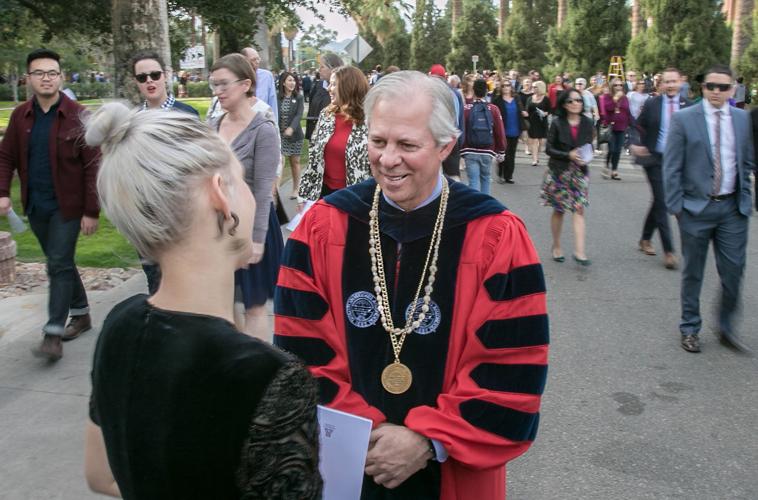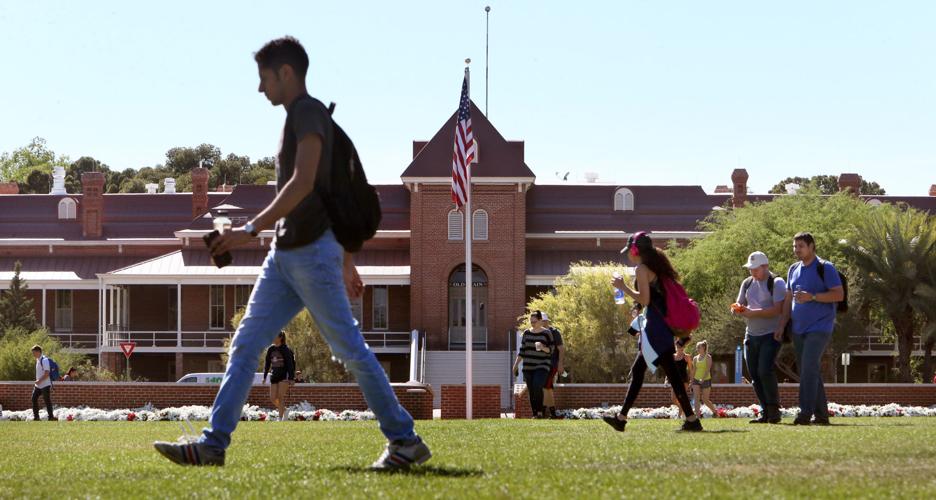The University of Arizona’s new president says he wants the school to be more competitive among its peer institutions — and a comparison of the UA and its peers when it comes to student retention, graduation rates, earning potential after school, and costs shows it has a way to go.
President Robert C. Robbins, who is in his first year as the UA’s leader, acknowledged the need for improvement at the school and laid out some of his goals, including breaking into the top 100 schools in the U.S. News and World Report colleges ranking, when he spoke before the Arizona Board of Regents in November.
“We are last among our peers and it’s not even close,” he said, referring to UA’s 124th position among the rankings. He wants to change that, in part by improving graduation rates and utilizing the school’s best resources.
The peer schools Robbins referred to were selected by the regents based on factors such as enrollment, retention, graduation rates, degrees awarded and research capabilities. The list includes both schools similar to the UA and those it aspires to be like.
The Star analyzed academic and financial data for the UA and 15 of those peers featured in the College Scorecard, a U.S. Department of Education initiative to make comprehensive data on higher education institutions’ outcomes more accessible. A comparison tool is available in an online version of this story at Tucson.com.
The most recent complete set of data available was for the 2015-2016 academic year. Some of the data used for comparison include admission and graduate rates, tuition fees, average debt and salary after graduation.
Among the Star’s findings from the analysis:
- Tuition at the UA was slightly above average among peers for both in-state and out-of-state students;
- UA was relatively easier to get into than most of its peer schools;
- Its graduation rate was slightly higher than the national average, but lowest among its 15 peers;
- UA graduates did not earn as much on average post-graduation as did graduates of the UA’s peer institutions.
“Comparisons to peer institutions provides valuable insight as the board gauges its strategic goals,” said Chad Sampson, the regents’ vice president for strategic planning.
UA spokesman Chris Sigurdson said he could not comment further on Robbins’ plans, as they are still being fleshed out.
Getting in, getting out
Robbins said he would like to make admission to the school more selective to increase graduation rates and boost the UA’s ranking.
The school wasn’t so selective in the 2015-2016 school year, when nearly eight out of 10 students who applied to the UA got in, compared with UCLA, the top performer on the list with a 17 percent admission rate.
The average admission rate among peer schools, including the UA, was 52 percent.
But not as many UA students came out with completed degrees within four to six years. It had the lowest graduation rate among peers at 61 percent, while the peer average was 82 percent. UCLA topped the list again at 91 percent.
To improve graduation rates, the UA is looking closely at student retention, said Kasey Urquidez, vice president of enrollment management and student affairs advancement and dean of undergraduate admissions. Those two things are closely related.
The UA said it is important to make sure freshman students succeed in their first year at school and come back for a second year. Increasing those number is a big hurdle.
As part of the university’s efforts to boost retention, Urquidez said UA launched an engagement initiative in 2015 to recognize students who participate in research, internships or other out-of-classroom experiences.
The goal is to make UA students feel more involved on campus and make them more marketable after they graduate, she said.
Bang for buck
Tuition costs at the UA for both in-state and out-of-state students were slightly above peer averages, the analysis showed.
Eight of the 15 peers schools charged their in-state residents less money for tuition than the UA. In the 2015-2016 school year, Arizona residents paid about $11,400 a year to be a Wildcat, while University of Florida charged in-state residents about $6,400. Pennsylvania State University’s main campus, the highest at about $17,000.
For out-of-state students, the University of Minnesota-Twin Cities had the best deal among the peer schools that year at $22,210, compared with the UA’s $32,630. Two peer schools in the University of California system were most costly to attend for out-of-state students.
Tuition fees for both resident and nonresident students at the UA have gone up since.
UA graduates also made less money on average 10 years after graduation than graduates at all but one peer school, Ohio State University. The UA graduates’ median salary was listed at $45,800, which is slightly higher than those of its state peers, Arizona State and Northern Arizona universities.
University of Maryland-College Park graduates made a median salary of about $61,700, the highest amount among the schools designated as the UA’s peers, followed by UCLA at $58,700.
But the data don’t take things like cost of living, which inflates salaries in areas like Los Angeles, into account, said Urquidez, the UA vice president. “But we are committed to preparing students for return on investments,” she said.
“We really believe in the education that we provide and the rate that we charge, we try to rightsize with merit awards and financial aid,” she said.
Going forward
Improving these numbers takes time, Urquidez said. Right now, the university wants to focus on growing the freshman class and increasing the number of community-college students who transfer to the UA.
She said, “As we go through with this strategic plan this year, we’ll be doing a lot of modeling and reviewing to determine what makes the most sense for the UA.”





